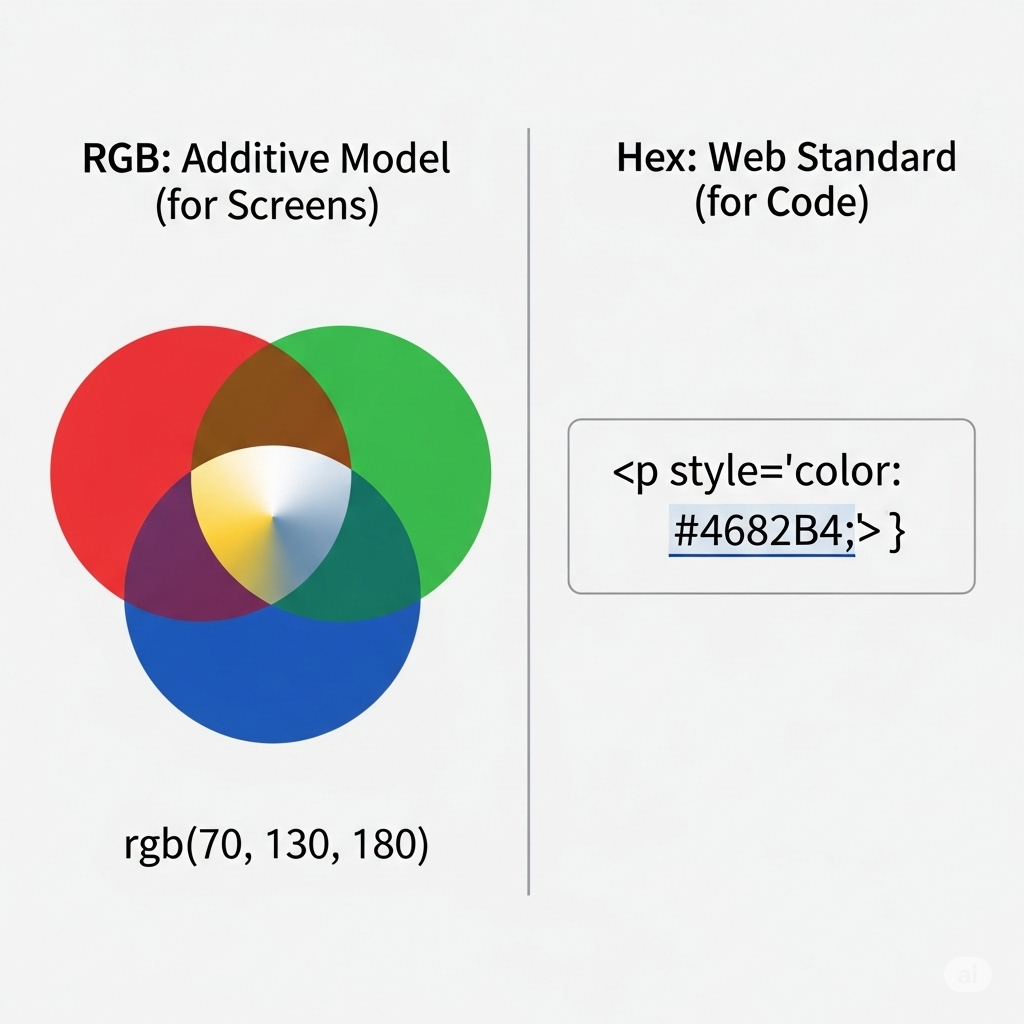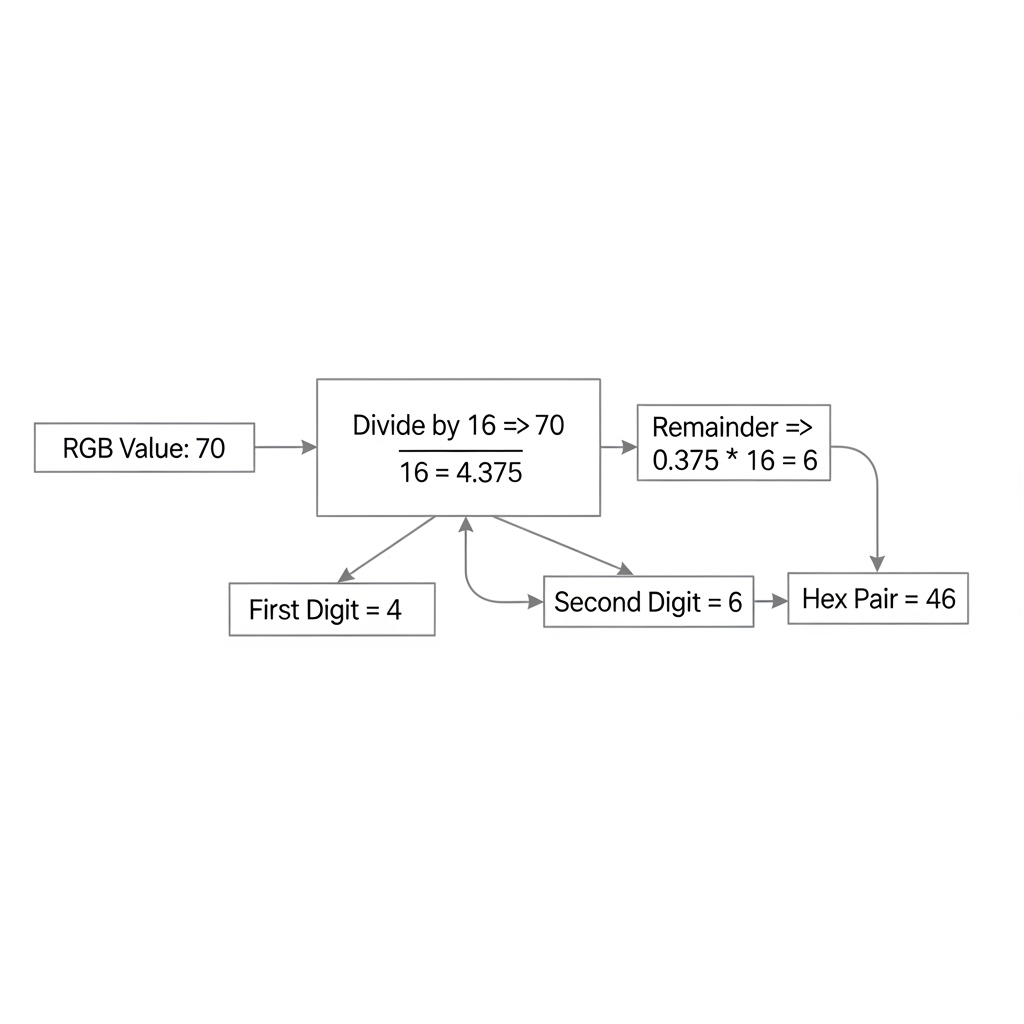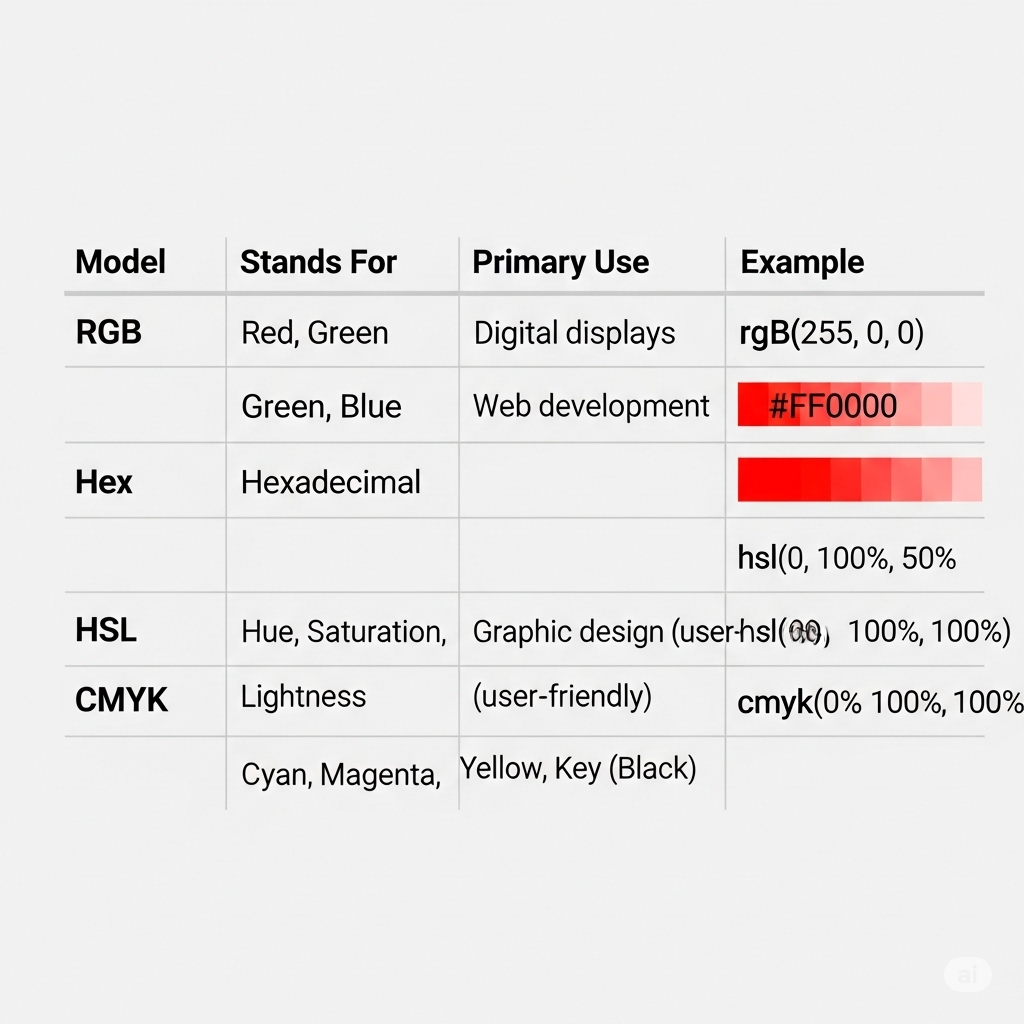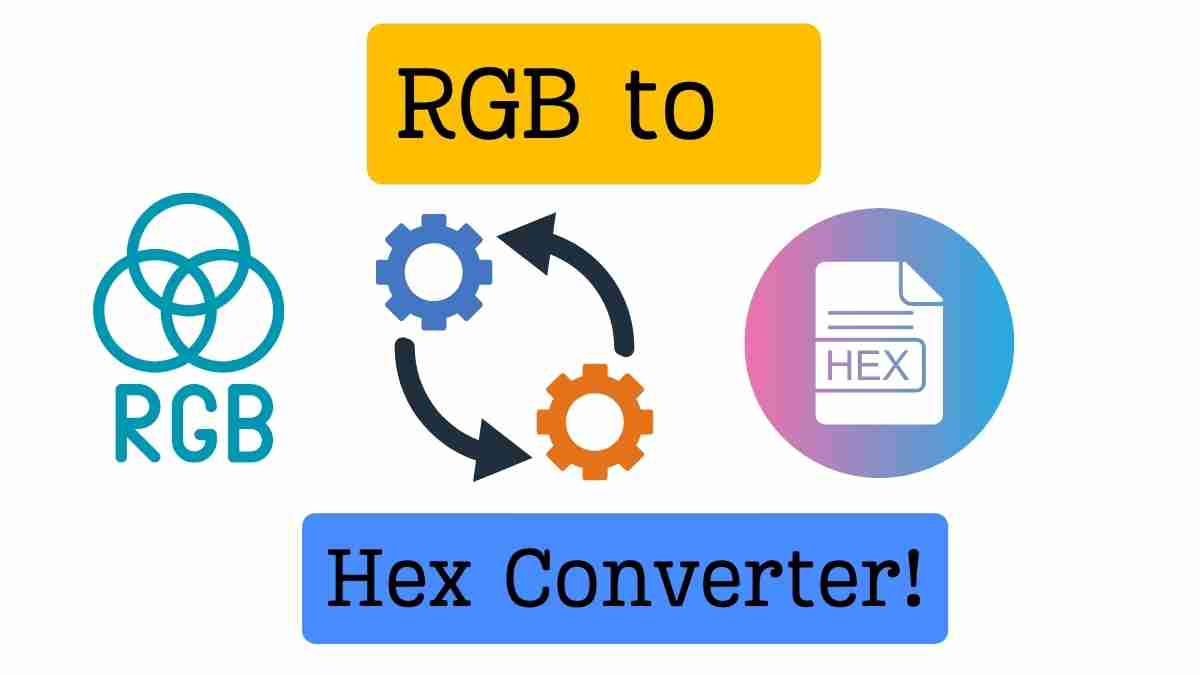RGB to Hex Converter
Quickly convert RGB to Hex and master digital color. This complete guide explains the why and how, with a free tool, manual steps, and pro tips for web design.
Share on Social Media:
The Ultimate RGB to Hex Converter: From Code to Color in Seconds
Ever stared at a beautiful color on your screen, maybe a stunning blue in a photograph or the perfect shade of green in a logo, and wondered, "How do I use that exact color in my website or app?" You might have its RGB values—like rgb(70, 130, 180)—but your code demands something else, a cryptic-looking code starting with a #.
You've just encountered one of the most fundamental tasks in digital design and development: converting RGB to Hex.
While a simple converter can give you the answer in a flash, truly understanding this process unlocks a deeper level of control over your digital creations. This guide will not only provide you with a fast and reliable converter but will also demystify the world of digital color, turning you from a color-copier into a color-commander.
(Imagine an interactive RGB to Hex converter tool embedded here. It would have three sliders for Red, Green, and Blue, ranging from 0 to 255. As the user adjusts the sliders, a color swatch would update in real-time, and the corresponding Hex code would be displayed below, with a "Copy" button.)
What Are RGB and Hex Colors, Really?
Before we can translate between them, we need to understand their language. Think of RGB and Hex as two different ways to describe the exact same thing, like saying "hello" in two different languages.
What is the RGB Color Model? The Language of Light
RGB stands for Red, Green, and Blue. It’s an additive color model, which means it creates colors by mixing different intensities of red, green, and blue light. This is the native language of screens—your computer monitor, smartphone, and TV all use this method.
How it Works: Each color (Red, Green, and Blue) is assigned an intensity value from 0 to 255.
0 means no light (the color is "off").
255 means full intensity (the color is "fully on").
By combining these three values, you can create over 16.7 million different colors (256 x 256 x 256).
rgb(0, 0, 0): No red, no green, no blue. The result is Black.
rgb(255, 255, 255): Full red, full green, full blue. The result is White.
rgb(255, 0, 0): Full red, no green, no blue. The result is pure, vibrant Red.
What is a Hex Color Code? The Language of the Web
A Hex code is a hexadecimal representation of an RGB color. It’s the preferred format for specifying colors in web design (HTML and CSS), and for good reason: it’s more compact and easier to manage in code.
A Hex code is a six-digit combination of numbers and letters, preceded by a hash symbol (#).
Structure: #RRGGBB
RR: Represents the red value.
GG: Represents the green value.
BB: Represents the blue value.
Instead of the 0-255 decimal system, it uses the hexadecimal system (base-16), which includes numbers 0-9 and letters A-F.
00 is the lowest value (equivalent to RGB's 0).
FF is the highest value (equivalent to RGB's 255).
So, rgb(255, 0, 0) becomes #FF0000. It’s the exact same color, just written differently.
Why Do We Even Need to Convert from RGB to Hex?

This is the crucial question most guides skip. If they represent the same color, why bother converting? The answer lies in practicality, standards, and efficiency.
Code Consistency and Readability
Imagine a CSS file for a large website. Using Hex codes creates a uniform and clean look. It's the industry standard for the web.
CSS
/* Using Hex (Clean and Standard) */
.button {
background-color: #4A90E2;
color: #FFFFFF;
border: 1px solid #3367A5;
}
/* Using RGB (More Verbose) */
.button {
background-color: rgb(74, 144, 226);
color: rgb(255, 255, 255);
border: 1px solid rgb(51, 103, 165);
}
The Hex version is more compact and universally understood by web developers at a glance.
Shorthand and Efficiency
Hex codes have a neat trick. If both digits in a pair are the same (e.g., #22AAFF), you can use a shorthand three-digit version: #2AF. While not a direct benefit of conversion, it’s a feature unique to the Hex format that promotes code brevity.
#FFFFFF can be written as #FFF.
#000000 can be written as #000.
#FF8800 can be written as #F80.
Including Transparency with RGBA and Hex Alpha
Modern web design often requires transparency. This is where the "A" for Alpha comes in.
RGBA: rgba(74, 144, 226, 0.5) adds a fourth value for opacity (0 for fully transparent, 1 for fully opaque).
Hex with Alpha: You can achieve the same by adding two more hexadecimal digits to the end of your Hex code: #RRGGBBAA. The AA (alpha) value also ranges from 00 (transparent) to FF (opaque).
Converting rgba(74, 144, 226, 0.5) to Hex with alpha would result in #4A90E280. This consistency is vital for modern UI design.
The Manual Conversion: How to Do It Yourself (and Actually Understand It)
Using an online tool is fast, but understanding the manual process empowers you. It’s a simple, two-step process for each of the R, G, and B values. All you need is division and a little bit of mapping.
The Hexadecimal Chart
First, remember how hexadecimal (base-16) works:
| Decimal | Hex |
|---|---|
| 0 | 0 |
| 1 | 1 |
| 2 | 2 |
| 3 | 3 |
| 4 | 4 |
| 5 | 5 |
| 6 | 6 |
| 7 | 7 |
| 8 | 8 |
| 9 | 9 |
| 10 | A |
| 11 | B |
| 12 | C |
| 13 | D |
| 14 | E |
| 15 | F |
The Two-Step Formula
For each RGB value (from 0 to 255):
Divide the number by 16. The whole number part of the result is your first Hex digit.
Multiply the remainder (the decimal part) by 16. The result is your second Hex digit.
Let's walk through an example.
Example: Convert rgb(70, 130, 180) to Hex
1. Convert the Red value (70):
Step 1: 70 / 16 = 4.375. The whole number is 4. Our first digit is 4.
Step 2: The remainder is 0.375. 0.375 * 16 = 6. Our second digit is 6.
So, the Red value is 46.
2. Convert the Green value (130):
Step 1: 130 / 16 = 8.125. The whole number is 8. Our first digit is 8.
Step 2: The remainder is 0.125. 0.125 * 16 = 2. Our second digit is 2.
So, the Green value is 82.
3. Convert the Blue value (180):
Step 1: 180 / 16 = 11.25. The whole number is 11. Looking at our chart, 11 is B. Our first digit is B.
Step 2: The remainder is 0.25. 0.25 * 16 = 4. Our second digit is 4.
So, the Blue value is B4.
Combine them: Put the results together, add a hash, and you get #4682B4. That's the Hex code for a lovely Steel Blue color!

A Deeper Dive: Beyond Basic Conversion
To truly master digital color, you need to know about its cousins in the color family.
Meet HSL and HSV: The Intuitive Color Models
While RGB is how screens create color, it's not very intuitive for humans. If you wanted to make a color slightly lighter, you'd have to guess how to adjust three different RGB values.
HSL (Hue, Saturation, Lightness) and HSV (Hue, Saturation, Value) are more human-friendly.
Hue: The pure color itself (e.g., red, green, blue). It’s represented as an angle on the color wheel (0-360 degrees).
Saturation: The intensity or "purity" of the color (0% is gray, 100% is the most vivid version).
Lightness/Value: The brightness of the color (0% is black, 100% is white in HSL; 100% is the pure color in HSV).
Designers often use HSL/HSV pickers to find a color and then convert it to RGB or Hex for use in their projects.
What About CMYK? The Language of Print
If you've ever worked with a professional printer, you've heard of CMYK. It stands for Cyan, Magenta, Yellow, and Key (Black). This is a subtractive color model, used for ink on paper.
Subtractive: It works by subtracting (absorbing) light. You start with a white surface (paper), and as you add ink, the surface gets darker.
Key Difference: RGB adds light to a black screen. CMYK subtracts light from a white page.
You cannot directly convert RGB/Hex to CMYK with perfect accuracy because they represent different "gamuts" (ranges of color). This is why colors sometimes look different on your screen than they do when printed.
RGB to Hex in the Real World: A Professional's Toolkit
Different professionals rely on RGB to Hex conversion in their daily workflows. Here’s how.
For Web Developers and Programmers
CSS and JavaScript: Directly using Hex codes in CSS for styling websites and web apps is the most common use case.
Frameworks and Libraries: Component libraries like Bootstrap and Tailwind CSS, and JavaScript frameworks like React and Vue, all use Hex codes for their default color palettes.
In-Editor Tools: Modern code editors like VS Code have built-in color pickers and extensions that show a color preview and allow for instant conversion right next to your code.
For UI/UX Designers
Design Systems: Designers create style guides and design systems in tools like Figma, Sketch, and Adobe XD. They define a brand's color palette using Hex codes to ensure consistency across all screens and components.
Handoff to Developers: When a design is complete, designers hand off the specifications to developers. Providing exact Hex codes is crucial for a pixel-perfect implementation.
Accessibility: UI/UX designers use tools to check the contrast ratio between text color and background color to ensure readability for people with visual impairments. These tools almost always use Hex codes as inputs.
For Graphic Designers and Digital Artists
Software Palettes: In Adobe Photoshop or Illustrator, the color picker tool allows you to see the RGB, Hex, HSL, and CMYK values all at once. Artists often pick a color visually and then copy the Hex code for use in other applications or for web versions of their work.
Brand Consistency: A graphic designer creating a logo will define the official brand colors using Pantone, CMYK (for print), and Hex (for digital) to ensure the brand looks the same everywhere.
Common Color Chart: RGB and Hex Equivalents
Here is a quick reference table for some common colors.
| Color Name | RGB Value | Hex Code |
|---|---|---|
| Black | (0, 0, 0) | #000000 |
| White | (255, 255, 255) | #FFFFFF |
| Red | (255, 0, 0) | #FF0000 |
| Green (Lime) | (0, 255, 0) | #00FF00 |
| Blue | (0, 0, 255) | #0000FF |
| Yellow | (255, 255, 0) | #FFFF00 |
| Cyan (Aqua) | (0, 255, 255) | #00FFFF |
| Magenta | (255, 0, 255) | #FF00FF |
| Silver | (192, 192, 192) | #C0C0C0 |
| Gray | (128, 128, 128) | #808080 |
| Maroon | (128, 0, 0) | #800000 |
| Olive | (128, 128, 0) | #808000 |
| Purple | (128, 0, 128) | #800080 |
| Teal | (0, 128, 128) | #008080 |
| Navy | (0, 0, 128) | #000080 |

Understanding RGB and Hex Color Models
As a professional in the digital realm, I find it imperative to utilize tools that facilitate efficient colour code transitions, such as an RGB to Hex Converter. This tool is convenient and crucial for ensuring accurate colour representation across various applications and platforms. The RGB colour model, which stands for Red, Green, and Blue, is predominantly used in electronic systems like monitors and cameras to create a broad spectrum of colours. On the other hand, the Hex colour model is a hexadecimal representation commonly employed in web design and development. By converting RGB to Hex, one can maintain the integrity of the original colour when translating it into a format suitable for web usage.
The Basics of RGB Color Coding
Understanding RGB values is crucial for accurate colour representation. Each colour in the RGB model is defined by a trio of numbers ranging from 0 to 255, corresponding to the intensity levels of red, green, and blue light. This granular control allows for over 16 million possible colour combinations. An RGB to Hex Converter simplifies web design colour-coding by translating these values into a six-digit hexadecimal format readily used in CSS and HTML codes, streamlining the design process and ensuring consistency across web pages.

What is a Hex Color Code?
A Hex Color Code is a six-digit, hexadecimal number used in web design to specify colours. The first two digits represent the red component, the middle two the green, and the last two the blue. This compact format has become the standard in defining colours in web development. By employing an RGB to Hex Converter, colour management becomes a more efficient task for developers, eliminating the need for manual calculations and reducing the likelihood of errors.
The Importance of Color Conversion Tools
Ensuring accurate colour representation with RGB to Hex Converter tools is not just about aesthetic appeal but brand integrity and user experience. These tools streamline web design processes by providing a quick and reliable method for translating complex RGB values into Hex codes, essential for consistent colour application across browsers and devices.
How RGB to Hex Conversion Works
An RGB to Hex Converter operates on a relatively straightforward principle. It takes the individual RGB values and converts each to a two-character hexadecimal string. These strings are then concatenated to form the complete Hex code. Understanding this process is critical for streamlined colour coding, as it allows designers to easily translate RGB values into the Hex format, which is necessary for web design and development.
Using an RGB to Hex Converter: A Step-by-Step Guide
To efficiently translate colour values using an RGB to Hex Converter, one must first input the RGB values into the converter tool. The tool then calculates the corresponding Hex code, which can be copied and used in your web design project. This process streamlines design workflows tremendously, eliminating the need to calculate and convert the colour codes manually.
Online Tools for Converting RGB to Hex
Numerous online tools that effortlessly transition from RGB values to Hex codes are available. These converters are designed to simplify web design colour code integration by providing a user-friendly interface where one can input RGB values and instantly receive the corresponding Hex code.
Benefits of Using an RGB to Hex Converter
Streamlining web design with an RGB to Hex Converter is one of the key benefits of using such a tool. It ensures colour consistency across platforms, vital for creating a cohesive user experience. Moreover, it saves time and reduces the likelihood of human error in colour code translation.
Manual Conversion: RGB to Hexadecimal Process
While it is possible to manually convert RGB values to Hexadecimal codes, utilizing an RGB to Hex Converter makes this process far more efficient. By automating the conversion, designers can focus on other aspects of their workflow, thereby enhancing project productivity and accuracy.
Common Uses for RGB to Hex Converters
Streamlining Web Design with RGB to Hex Converter Tools is a typical application of these utilities. They are also extensively used in enhancing graphic workflows, where designers frequently need to match colours across various digital assets and ensure consistent branding.
Integrating RGB to Hex Conversion in Web Design
Integrating an RGB to Hex Converter tool in web design workflows is brilliant for any developer. It ensures colour consistency across platforms and saves time, allowing designers to focus on more creative aspects of their projects.
Accuracy in Color Representation: RGB vs Hex
Understanding both RGB and Hex is fundamental for accurate colour representation. While RGB is more intuitive for humans to understand and manipulate, Hex codes are the web language. Utilizing an RGB to Hex Converter simplifies the translation between these two colour models, ensuring that the colours you work with are accurately represented in the digital space.
Troubleshooting Common RGB to Hex Conversion Issues
It's essential to ensure that the RGB to Hex Converter supports all colour ranges to avoid discrepancies in colour representation. Regularly checking for updates to the RGB to Hex Converter can also prevent potential issues arising from outdated software.
Customizing Colors in Digital Design with RGB to Hex
Understanding the RGB to Hex Converter is essential for efficient colour customization in digital design. This tool lets designers quickly and accurately adjust colours to their precise specifications, streamlining design workflows and ensuring high customization.
The Role of RGB to Hex Converters in Graphic Software
In graphic software, an RGB to Hex Converter ensures precise colour representation, which is critical for professional design work. Converters streamline workflow for designers by simplifying the input of colour codes, allowing for more focus on the creative aspects of design.
Optimizing Website Colors for Accessibility
Utilizing an RGB to Hex Converter is critical to ensuring precise colour selection, particularly when optimizing website colours for accessibility. This tool helps maintain colour consistency across platforms, providing all users with an accurate and uniform experience.
Converting Color Codes for CSS: Practical Tips
An RGB to Hex Converter is indispensable for streamlined colour selection in CSS. It allows developers to easily incorporate consistent colour coding into their stylesheets, ensuring the website's colours match the intended design.
Understanding Color Harmony: RGB to Hex in Design
Leveraging an RGB to Hex Converter is crucial for ensuring precise colour matching and is integral to achieving colour harmony in design. This tool aids in streamlining design workflows, making it easier to create visually appealing and cohesive designs.
The Impact of Color Conversion on Brand Identity
Consistency in brand identity is heavily reliant on precise RGB to Hex conversion. An easy-to-use RGB to Hex Converter strengthens branding efforts by ensuring brand colours are accurately replicated across all digital media.
Automating Color Conversion in Development Workflows
Automating colour conversion with an integrated RGB to Hex Converter can significantly streamline design processes. It ensures accurate colour representation by removing the manual steps in converting colour codes, which can be time-consuming and prone to error.
Ensuring Color Consistency Across Digital Platforms
To maintain a consistent brand image and user experience, utilizing an RGB to Hex Converter for consistent colour application is vital. This tool becomes integral to design workflows, ensuring that colours remain uniform across various digital platforms.
Exploring Advanced Features of RGB to Hex Conversion Tools
Advanced features of RGB to Hex Conversion Tools can greatly enhance precision in web design colours. These tools often include additional functionalities that streamline colour code integration for developers, making working with colours much more efficient.
Color Conversion for Print vs. Digital Media
Understanding RGB to Hex conversion is crucial for maintaining colour consistency in digital media and achieving accurate colour reproduction in print. Leveraging an RGB to Hex Converter can help bridge the gap between how colours are represented on-screen and how they appear when printed.
Educational Resources for Learning Color Code Conversion
To enhance one's web design workflow, utilizing educational resources focusing on efficient colour code translation with an RGB to Hex Converter is beneficial. These resources can provide valuable insights into the best practices for using these tools effectively.
Future Trends in Color Code Conversion Technology
Looking forward to future trends in colour code conversion technology, we can expect enhanced accuracy in RGB to Hex Converter algorithms for precision and streamlined interfaces that increase the usability of these tools. As technology evolves, so will the capabilities of these converters, making them even more integral to the design process.
Conclusion: Color at Your Fingertips
Converting from RGB to Hex is more than just a mechanical task; it’s the bridge between the way screens create color and the way developers command it. While a good converter tool is indispensable for speed and efficiency, understanding the "how" and "why" behind the process gives you the confidence to manage digital color in any context.
You now know that RGB is the language of light, Hex is the language of the web, and the translation between them is a simple, lossless mathematical process. You're equipped to handle transparency with RGBA, speak intelligently about related models like HSL and CMYK, and perform the conversion manually.
The next time you need to bring a specific shade from an idea to the screen, you’ll have the knowledge and the tools to do it with precision and purpose.
Frequently Asked Questions (FAQ)
1. Is there any quality loss when converting RGB to Hex? Absolutely not. Because RGB and Hex are just different notations for the same 24-bit color model, the conversion is a direct mathematical translation. The color produced is identical.
2. What are "web-safe" colors? Are they still relevant? Web-safe colors are a palette of 216 colors that were guaranteed to look the same on old computer systems that could only display 256 colors. In the early days of the web, this was important for consistency. Today, with modern screens capable of displaying millions of colors, the concept of web-safe colors is largely obsolete.
3. How do I convert an RGBA value to a Hex code? You convert the R, G, and B values as usual. For the Alpha value (which is a decimal between 0 and 1), you multiply it by 255 and then convert that result to a two-digit Hex value. For example, an alpha of 0.5 is 0.5 * 255 = 127.5 (round to 128), which is 80 in Hex. You then append this to the end of the code: #RRGGBBAA.
4. Can a Hex code be 3 digits? Yes. If each of the three pairs in a six-digit Hex code has identical digits (e.g., #112233), it can be written in a shorthand format (#123). The browser automatically interprets #123 as #112233. This is just a convenience for developers.
5. What is the difference between #000 and #000000? There is no difference in the final color. Both represent pure black. The three-digit version is simply a more concise way to write the six-digit code when the pairs are duplicated.
6. Why does the Hex system use letters A-F? The decimal system we use daily is "base-10" (it has ten digits, 0-9). The hexadecimal system is "base-16." To represent the values for 10, 11, 12, 13, 14, and 15 with a single character, the letters A through F are used.
7. How can I pick a color from an image and get its Hex code? Most image editing software (like Photoshop) has an "eyedropper" or "color picker" tool. You can click on any pixel in an image, and the tool will show you its RGB and Hex values. There are also browser extensions and standalone apps that provide this functionality for anything on your screen.
8. Is #FFF the same as #FFFFFF? Yes. They are both representations of pure white. The browser expands the three-digit shorthand into the full six-digit version.
External Links (Authoritative References)
Wikipedia: RGB color model: For a deep, technical dive into the history and science of the RGB model.
W3C: CSS Color Module: The official standards documentation for color in web development, the ultimate source of truth.
College of the Desert: RGB to Hex Conversion: An example of an educational resource providing a similar tool and explanation, adding to the trustworthiness.